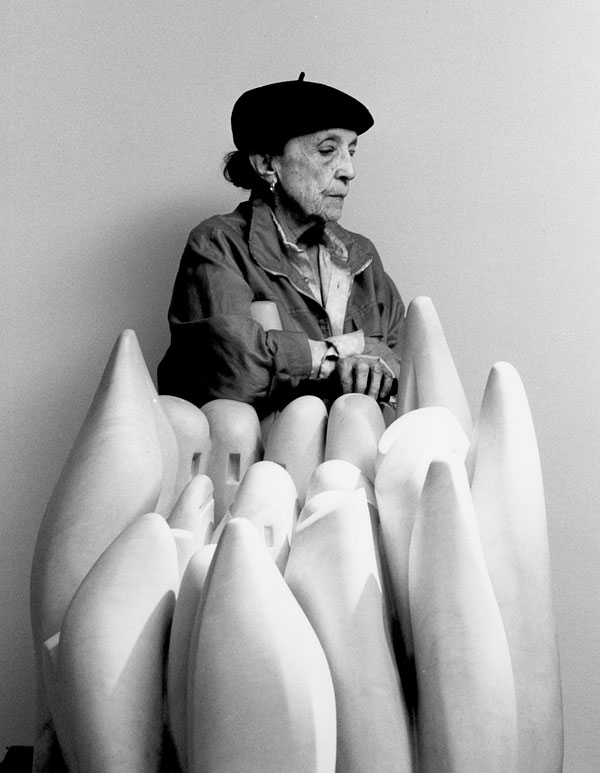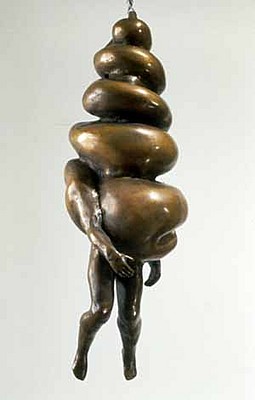.Biography.
"For me, sculpture is the body. My body is my sculpture." ~Louise Bourgeois

Louise Bourgeois in 1990, behind her marble sculpture, Eye to Eye (1970). photo by Raimon Ramis
photo taken from http://www.centrepompidou.fr/education/ressources//ENS-bourgeois-EN//ENS-bourgeois-EN.html
Louise Josephine Bourgeois
Louise was born on Christmas Day, 1911 in Paris. Her parents, Louis and Josephine owned a small tapestry restoration business. Louise had one sister, Henriette and one brother, Desire, who was killed in 1915 in the war against Germany. At age ten Louise began helping her parents in the tapestry workshop and attended the Lycee in Paris. In 1921 Louise is forced to pause her education and move south when her mother becomes ill with the Spanish Flu. To compensate, Louise’s parents hired Sadie Gordon, a young Englishwoman, to tutor the girls in English. Not soon after, her father and Sadie began to have an affair that threatens to tear the family apart. Feeling a deep sense of betrayal, Louise begins to dream of killing her father’s mistress by ringing her neck the same way she was taught to twist the tapestry dry. Even today, Louise practices this technique in her artwork, creating sculptures, like Spiral Woman (shown below) with spirals and twisted shapes.

Louise Bourgeois, Spiral Woman, 1984. Painted wood and stainless steel
The Museum of Modern Art, New York. Gift of the artist (by exchange), 2001
photo taken from http://tattingmydoilies.blogspot.com/2008_08_01_archive.html
In 1932, Louise’s mother dies, leaving Louise feeling empty and betrayed. Inspired by her mother, Louise went on to receive a degree in philosophy from the Sorbonne of the University of Paris. In 1933, however, Louise decides to pursue art. She attended many academies and studio workshops. Finding a new passion, she begins to experiment with sculptures. Fired on by her internal resentment for her father, Louise captures her true feeling in sculptures inspired by her past. In The Destruction of the Father (shown below), Louise pictures her father lying dismembered on the family dinner table, where he had scornfully hurt her so many times before. Louise says the work is about confronting her fear. It is through her artwork Louise is allowed to release all of her aggressive feelings.

Louise Bourgeois, The Destruction of the Father, 1974
Plaster, latex, wood, fabric and red light
Courtesy Cheim & Read, Galerie Karsten Greve and Galerie Hauser & Wirth © Louise Bourgeois Photo: Rafael Lobato
photo taken from http://currentartpics.blogspot.com/2007/12/65.html
While attending school in Paris, Louise dabbled in painting. The famous painter Fernand Leger*, visited Louise’s school one day and recognized Louise’s work, not for her painting skills but for her eye for shapes. This encounter persuaded Louise to completely break away from tapestry and into a whole new world. Louise opened a small art gallery next door to her father’s tapestry shop, where she met her husband Robert Goldwater. Louise admits that she was first attracted to Robert because her father did not approve of him. Louise and Robert soon adopt a son, Michel Olivier, in 1939. They move to New York City and have two more sons, Jean-Louis and Alain Mathew Clement.
In 1939, Louise enrolls in the Art Students League in New York City, where Robert and she socialize with major art-world figures. By 1950, Louise’s work has been exhibited in seven different major art shows including a solo show of paintings in the Bertha Schaefer Gallery. Today, Louise remains in New York City but often travels to museums in Europe. Her artwork is still displayed in many galleries and museums around the world.
* For more information on Fernand Leger visit http://www.mcs.csueastbay.edu/~malek/Leger.html